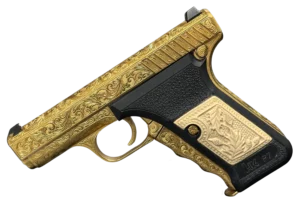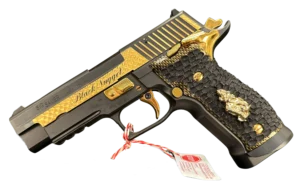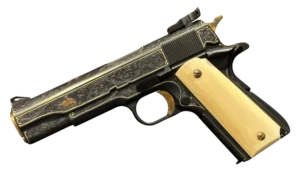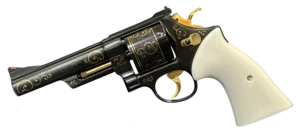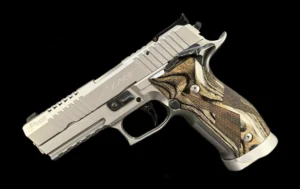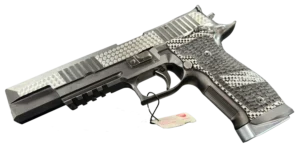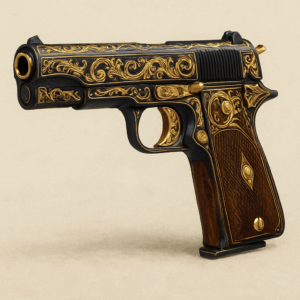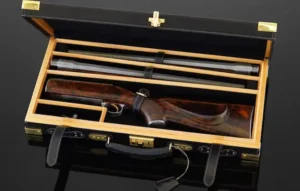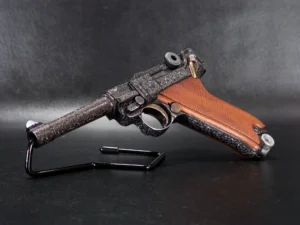Key Takeaways:
- Heckler & Koch firearms aren’t just built—they’re engineered with purpose: Whether it’s the modular design of the G36 or the battlefield durability of the HK 416, each firearm exists to solve a real-world problem. HK doesn’t design for hype—they design for reliability, performance, and adaptability when it matters most.
- Every HK model on this list owns its category by doing one thing exceptionally well: The MP5 redefined close-quarters control, the PSG1 set a benchmark for long-range precision, and the USP offered rugged versatility in a sidearm. These aren’t “do-it-all” tools—they’re finely tuned instruments crafted for specific roles.
- Owning an HK firearm is about more than specs—it’s about trust, heritage, and long-term value: From elite special forces to everyday range shooters, HK guns have earned loyalty not just for how they shoot, but for how they hold up. You’re not just buying a gun—you’re buying into a tradition of uncompromising quality.
What Makes HK a Giant in the Firearms World
Let’s be honest—some names in the gun world carry more weight than others. Heckler & Koch is one of those names. Whether you’re talking to a military armorer, a law enforcement vet, or a weekend range regular, odds are the letters “HK” mean something: reliability, precision, and uncompromising German engineering.
You’ll find their guns on the hips of elite operators, in the hands of police units worldwide, and proudly displayed in civilian collections. And it’s not just reputation talking. These firearms earn their respect one round at a time—through combat, through stress, and through years of tough service.
So, what makes an HK gun so trusted?
It’s not just that they’re built well (they are). It’s that they’re built with a clear purpose: to work when everything else doesn’t. From the iconic MP5 to the cutting-edge HK416, these firearms have not just followed trends—they’ve set them. This article breaks down five of HK’s most important contributions to modern firepower and why they continue to stand apart in a market crowded with contenders.
And if you’re new to this space, don’t worry. You’ll come away knowing why HK is more than a brand—it’s a benchmark.
A Legacy Forged in Postwar Steel: The Heckler & Koch Story
Heckler & Koch wasn’t born in a golden age. It rose from the ashes—literally. In 1949, just four years after World War II, three engineers (Edmund Heckler, Theodor Koch, and Alex Seidel) started the company in the shell of the Mauser factory in Oberndorf, Germany. Their goal was straightforward but ambitious: build firearms that didn’t just meet the standard but redefined it.
You’ve probably heard the phrase “German engineering” tossed around in conversations about cars or optics. HK took that idea and applied it to firearms, obsessing over precision tolerances, materials science, and user-focused functionality. These weren’t just weapons—they were instruments.
Throughout the decades, HK became known for doing things differently. They weren’t afraid to rethink the mechanics of a rifle or create entirely new locking systems. The roller-delayed blowback mechanism alone, introduced in the G3 and later refined in the MP5, changed how people approached reliability in automatic firearms.
And while many manufacturers leaned heavily into civilian markets, HK made its mark in military contracts and law enforcement—environments where failure is not an option.
But here’s the twist: they didn’t just make guns for soldiers. They made them for shooters who demanded excellence, no matter the setting. That ethos—craftsmanship without compromise—runs through every trigger pull of an HK firearm.
So, whether you’re holding a polymer-framed USP or shouldering a modern G36, you’re carrying a slice of that legacy. Let’s take a closer look at the five models that define HK’s reputation for serious performance.
The HK G36 – Lightweight, Adaptable, and Built for Modern Battle
When the G36 hit the scene in the mid-1990s, it wasn’t just a new rifle—it was a hard pivot from the past. Germany was ready to move on from the heavy, steel-framed G3, and Heckler & Koch answered the call with something radically modern: a lightweight, modular rifle that looked and felt like it belonged in the 21st century.
You could almost call it the “anti-G3.” Gone were the old-world materials and traditional aesthetics. In their place? Reinforced polymer, integrated optics, and a design that screamed efficiency. Soldiers noticed. So did engineers. So did the rest of the firearms industry.
At the heart of the G36’s appeal is how it wears multiple hats without sacrificing performance. It’s a true modular platform. Want a shorter barrel for close-quarters work? Swap it out. Need optics for long-range precision? Already built-in.
Here’s what sets it apart:
- Polymer Body: Lightweight yet shockingly tough. It takes abuse without adding bulk.
- Built-In Sights: The integrated carry handle includes optical sights, reducing the need for add-ons right out of the gate.
- Folding Stock: Saves space without compromising shooting stability.
- Quick-Change Barrel: No tools, no drama—just mission-specific flexibility.
The G36 wasn’t just built to be carried—it was built to be used. Whether clearing buildings or holding a perimeter, its balance and ergonomic layout reduce fatigue and boost control. And when the mission stretches into hours or even days, that matters a lot more than people think.
But what really cements the G36’s place on this list is its field record. Used by German Bundeswehr troops, Spanish forces, and special units in Asia and Latin America, it has proven time and again that it thrives under pressure. Mud, heat, cold, you name it—the G36 just keeps going.
Sure, it’s had its controversies (as all long-serving military rifles do), but the core design remains a case study of how to do modern military rifles right.
If you’re looking for a rifle that blends form, function, and futuristic thinking, the HK G36 still deserves serious respect.
The HK 416 – Special Forces Approved, Battlefield Proven
If the G36 was a step into the future, the HK 416 was a calculated correction. You see, for all the things the AR-15/M4 platform got right—modularity, familiarity, accessory compatibility—there was always one glaring weakness: the direct impingement gas system.
It ran dirty. It fouled chambers. It caused problems, especially in environments where maintenance windows were few and far between.
So what did Heckler & Koch do? They kept the things that worked about the AR platform and replaced the weak link. Enter the HK 416: a rifle that looked familiar but ran cleaner, cooler, and more reliably thanks to its short-stroke gas piston system.
Think of it as an AR that grew up in a German engineering lab.
Here’s why it matters:
- Gas Piston System: Cleaner and more reliable than direct impingement. Less fouling = longer run time between cleanings.
- Cold Hammer-Forged Barrel: Incredibly durable, shockingly accurate.
- Full Compatibility: Uses standard AR mags and accessories but is built like a tank.
- Battle-Tested: Yes, this is that rifle—the one used during the operation that killed Osama bin Laden.
That last point isn’t just trivia—it’s proof. When the highest-stakes mission in recent military history needed a rifle, the HK 416 made the cut.
It also helps that it handles beautifully. The recoil impulse is smoother. The balance is dead on. You can shoot it fast and still stay on target. Operators and special forces around the world have gravitated to it for exactly those reasons.
And yet, for all its battlefield credibility, the HK 416 isn’t just a tool for black ops teams. Civilian shooters—especially those in countries where semi-auto versions are available—appreciate it for its precision and build quality. It’s not the cheapest rifle on the market, but few who own one ever regret the purchase.
Honestly, if you could only have one HK rifle for tactical use? The 416 might be it. It’s one of those rare guns that feels like it was built around real-world problems, not just blueprints.
The HK MP5 – A Submachine Gun So Good, It Became a Legend
There are guns you recognize. And then there are guns, you know, almost instinctively—the HK MP5 falls squarely in that second category.
You’ve seen it everywhere: in movies, video games, and real-world footage of elite tactical teams breaching doors. But this isn’t just a case of good branding. The MP5 earned its legendary status by doing one thing better than anyone else in the 1960s, ’70s, and even today—dominating close-quarters combat.
Here’s the thing: when the MP5 debuted in 1966, most submachine guns were blunt instruments—fast-firing, sure, but not what you’d call elegant. HK changed the game with a roller-delayed blowback system that delivered an unusually smooth, accurate, and controllable shooting experience.
The result? A compact weapon that felt more like a scalpel than a sledgehammer.
What makes it tick:
- Roller-Delayed Blowback: Offers superb recoil control for rapid, accurate fire.
- Compact Frame: Ideal for tight quarters, from hostage rescues to urban ops.
- Modular Options: Suppressors, optics, foregrips—you name it, it fits.
- Dead-On Accuracy: Rare in sub guns, but the MP5 makes it look easy.
Law enforcement and counterterrorism units quickly took notice. The British SAS used it during the famous Iranian Embassy siege in 1980, cementing the MP5’s reputation as the go-to for high-stakes operations. Since then, it’s been adopted by dozens of agencies and militaries around the world.
But here’s what’s really interesting: the MP5 never tried to reinvent itself with flashy gimmicks. Sure, there are variants—some ultra-compact, others suppressed—but the basic DNA of the gun hasn’t changed in decades. It didn’t need to.
Even civilian shooters (where legal) flock to it, not just for its heritage but because it’s still one of the most enjoyable 9mm platforms out there. It runs smoothly. It runs quietly. It’s built like a vault door. And it feels right in your hands.
So, is the MP5 still relevant in an age of PDWs and SBRs? Absolutely. Because some designs don’t get old—they just become classics.
The HK USP – The Pistol That Put Polymer and Precision in the Same Holster
Now, let’s switch gears from full-auto fire to something you can carry daily: the HK USP.
Launched in the early ’90s, the Universal Self-loading Pistol was HK’s answer to a pretty straightforward question: Can we build a sidearm tough enough for combat but refined enough for competition—and still friendly for everyday carry?
The answer, in typical HK fashion, was not just “yes,” but “we’ll do you one better.”
Built around a recoil-reduction system and a polymer frame (back when that still raised eyebrows), the USP brought a new level of engineering to the pistol world. It was rugged. It was versatile. And it could handle just about anything you threw at it.
Standout features?
- Recoil Buffer System: Cuts down felt recoil and muzzle flip for faster follow-ups.
- Polymer Frame with Steel Inserts: Lightweight without losing strength.
- Ambidextrous Controls: Safety, de-cocker—easy access no matter your hand.
- Trigger Configs Galore: DA/SA, LEM, decocker-only—you name it.
And here’s the fun part: it wasn’t just one-size-fits-all. HK offered multiple variants in different calibers—9mm, .40 S&W, and .45 ACP—each tuned for its own kind of shooter. The USP Compact, for instance, quickly became a favorite for concealed carry.
It wasn’t trying to be flashy. It was built to work. Police departments across Europe and the U.S. adopted it, and shooters in the civilian market quickly followed. You’d see it in everything from IDPA competitions to glove compartments.
Even in the media, the USP earned some spotlight, showing up in countless action movies and TV shows, often as the weapon of choice for characters who needed something serious but not flashy. That sort of quiet confidence mirrors the gun itself.
Let’s not overlook one of its biggest assets: customization. Between the various trigger packs, accessory rails, and available suppressor-ready variants, the USP feels less like “a gun” and more like a personalized toolkit. You set it up your way, and it just works.
So, whether you’re a duty officer, weekend warrior, or serious collector, the USP delivers. It’s not the lightest, the cheapest, or the trendiest pistol out there—but it might just be the one you never want to trade away.
The HK PSG1 – When Accuracy Isn’t a Luxury, It’s a Necessity
There’s precision shooting—and then there’s the kind of precision that doesn’t allow for second chances. That’s where the PSG1 comes in.
Heckler & Koch didn’t design this rifle for the battlefield chaos of standard infantry. They built it for the kind of mission where one shot needs to count every single time—hostage situations, counter-terror raids, high-risk overwatch.
Introduced in the 1970s, the PSG1 (short for Präzisionsschützengewehr 1) wasn’t just another sniper rifle. It was a statement. HK basically took everything they knew about accuracy, durability, and shooter ergonomics… and went all in.
So, what makes it such a legend in the world of long guns?
- Free-Floating, Cold-Hammer-Forged Barrel: A mouthful, sure, but it means dead-on accuracy with minimal vibration.
- Adjustable Everything: Stock, cheek rest, butt plate, trigger—if it affects your shot, you can dial it in.
- Match-Grade Trigger: Smooth as silk, crisp as a winter snap.
- Scope-Ready: Usually paired with high-end optics for extreme clarity at a distance.
It’s not a rifle you run through the mud. It’s the rifle you zero once and trust forever. Built on a modified G3 platform, the PSG1 brings all the benefits of HK’s roller-delayed system, tuned for maximum precision.
And it’s not just paper-target accurate. We’re talking real-world accuracy in actual engagements. Many European police units adopted the PSG1 specifically for sniper intervention scenarios—like hostage standoffs or coordinated takedowns where the window of action might be seconds wide.
There’s also something undeniably elegant about it. It’s heavy. It’s long. It looks like a precision instrument because it is one. This isn’t the kind of rifle you grab off a rack on impulse—it’s the one you invest in when you know exactly what you’re doing.
So why doesn’t everyone own one? Simple: they’re rare, expensive, and purpose-built. But among those who know—serious long-range shooters, elite law enforcement, and military DMR units—the PSG1 is still regarded as a gold standard. Not just a sniper rifle, but a sniper rifle.
The Face-Off: What Sets These Five HK Firearms Apart
At this point, you might be thinking: “Okay, they’re all solid—how do you actually compare them?”
Fair question. Each of these Heckler & Koch firearms wasn’t built to be the best gun ever in a vacuum. They were built to own their specific category. What ties them together is purpose-driven engineering—what sets them apart is how they solve different problems.
Here’s how they stack up, not in terms of hype, but real-world strengths:
- HK G36 – The Mission-Changer
- If you need a lightweight rifle with plug-and-play versatility, this is your friend. Perfect for armies updating legacy systems or special units who swap roles mid-deployment. Think of it as the Swiss Army knife of battle rifles—with a polymer chassis.
- HK 416 – The Operator’s Dream
- Do you want something that runs cleaner, shoots flatter, and won’t jam in a sandstorm? This is it. The 416 fixed what was wrong with the AR platform and made it combat-hardened. It’s not cheap, but it works, even when everything else doesn’t.
- HK MP5 – The Room-Clearing Classic
- Short-range precision with a surgical edge. Whether it’s a SWAT team hitting a meth lab or a bodyguard clearing a hallway, the MP5’s smooth cycling and tight grouping make it the sub-gun everyone else is still trying to copy.
- HK USP – The Pistol That Covers All Bases
- This is the sidearm for the serious shooter who wants durability, comfort, and customization. Duty gun, competition pistol, range toy—it doesn’t matter. The USP handles it, and it won’t complain after 10,000 rounds.
- HK PSG1 – The Ultimate Precision Tool
- If you measure performance in millimeters, not inches, here’s your rifle. Built for quiet professionals and marksmen who demand zero compromises. It’s heavy, expensive, and precise as hell. And worth every ounce and every penny.
HK in the Spotlight: From Real Ops to Hollywood Reels
Heckler & Koch doesn’t chase fame. It earns it.
And yet, HK firearms have become some of the most recognizable guns on screen—without ever feeling like product placements. Why? When filmmakers, prop masters, or game designers want to signal authority, precision, or elite tactical power, they reach for an HK.
Let’s start with the movies. You’ve seen the MP5 in everything from Die Hard to Heat. That distinctive silhouette—the slim foregrip, the compact stock, the curved magazine—is practically shorthand for “this scene just got serious.”
The USP? It’s made the rounds, too, showing up in the hands of action heroes and antiheroes alike. And the HK416? That one has a real-world resume that’s hard to top—and that’s exactly why it’s featured in everything from Zero Dark Thirty to Call of Duty.
And speaking of games—if you’ve played any tactical shooter in the last two decades, you’ve probably handled digital versions of HK’s greatest hits. Whether you’re running through Rainbow Six maps or storming buildings in Modern Warfare, the HK lineup is there, coded into every trigger pull and reload animation.
But beyond the flash and fantasy, HK guns are still hard at work. Real-life military units—from U.S. Navy SEALs to German KSK—trust HK rifles and pistols not because they look cool but because they work under pressure. Law enforcement SWAT teams across the globe rely on the MP5 and USP, year after year, because of their reliability and ease of use.
So yes, HK has a pop culture cachet. But it’s not just for show. It’s earned by performance in places where performance can’t be faked.
Let’s break it down:
- Movies & TV: MP5, USP, and 416 show up frequently—usually in the hands of the “serious” characters.
- Video Games: From Call of Duty to Rainbow Six, HK models are mainstays due to their real-world acclaim.
- Military Units: HK416, MP7, and G36 are used by elite units across NATO and beyond.
- Law Enforcement: The MP5 is still a staple in tactical entry teams worldwide.
HK isn’t chasing trends. It’s setting them—and the rest of the world just keeps watching.
Thinking of Buying an HK? Read This First
Whether you’re a seasoned collector with a safe full of steel or someone who’s just getting their feet wet in the firearms world, choosing the right Heckler & Koch model is more than just picking a name from a list. HK guns aren’t mass-market throwaways—they’re precision tools. So it’s worth thinking through your choice.
Start with the “Why”
What do you actually need it for?
- Home defense? The USP Compact or full-size in 9mm or .45 offers rock-solid reliability and manageable recoil.
- Is the range toy with some serious pedigree? The MP5 clone (like the SP5) is a joy to shoot—and looks damn good doing it.
- Tactical training or serious competition? The HK416 (civilian variant MR556) gives you AR familiarity with battle-hardened improvements.
- Long-range precision? The PSG1—if you can get one—or even an MR762 will deliver on accuracy.
Consider Your Experience Level
HK guns are built tough, but that doesn’t mean they’re always beginner-friendly in terms of cost or complexity. If you’re new to firearms, you may want to start with something a little more approachable and then graduate. That said, if you want to start with quality from the jump, there’s no shame in reaching straight for an HK USP or SP5.
Think About Budget—and Value
HK firearms aren’t cheap, and frankly, they’re not meant to be. These aren’t guns you shoot a few times and forget. They’re long-term investments. And because they hold value well, especially in the collector’s market, you’re not likely to lose money on a well-kept HK.
Also worth noting: quality accessories matter. HK optics, suppressor compatibility, and trigger upgrades are all part of the experience, and they can add to the price. Plan accordingly.
Customization and Compatibility
While HK isn’t known for having the endless aftermarket of, say, Glock or AR-15 platforms, many of their rifles (like the MR556 and G36 variants) still allow for thoughtful customization. Just be ready to use HK-specific parts or licensed options. Good gear isn’t always cheap—or universal.
Summary Buying Tips:
- Purpose: Define what you’re buying the firearm for.
- Comfort: Test grip, controls, and recoil if possible.
- Cost: Think long-term value, not just sticker shock.
- Support: Learn about parts availability and warranty options.
Remember, buying an HK isn’t about chasing the biggest name—it’s about choosing excellence in a form that fits your life. Whether you’re protecting your home, training on the weekend, or adding a crown jewel to your collection, HK has a model that’s not just good—it’s exactly right.
Conclusion: Heckler & Koch—Precision That Speaks for Itself
At this point, it’s not just about specs or stats anymore. It’s about something deeper—trust.
When you pick up a Heckler & Koch firearm, you’re holding more than a tool. You’re holding a legacy that spans over 70 years of hard-earned credibility. You’re feeling the weight (sometimes literally) of deliberate design choices, made not for show, but for survival. For performance. For people who can’t afford to second-guess their gear.
Whether it’s the unstoppable reliability of the MP5, the field-tested superiority of the 416, or the near-clinical precision of the PSG1, each firearm on this list tells its own story. Different guns. Different missions. Same standard.
And that’s the point, really. HK doesn’t make guns to fit in—they make guns to stand out where it counts: in the hands of the user, under pressure, in real-world moments when everything else falls away except performance.
They don’t flood the market with gimmicks. They don’t release a new model every six months. They just build things right. And they’ve been doing it long enough to know that craftsmanship never goes out of style.
So if you’re looking to buy your first HK or add another to your stable, know this: you’re not just buying a firearm. You’re buying a design philosophy. One built around reliability, engineered for excellence, and tested by the toughest critics on earth—operators, officers, and ordinary shooters who won’t settle for “good enough.”
And sure, other companies make great guns too. But Heckler & Koch? They make the ones you never forget.
Frequently Asked Questions
Short answer? You’re paying for world-class engineering. HK doesn’t cut corners. From the materials to the testing process, every step is deliberate. These aren’t guns cranked out for the masses—they’re precision-built tools designed to last, often through brutal environments and high-round counts. Think of it like buying a Leica instead of a disposable camera: you feel the difference every time you use it.
It’s not just relevant—it’s still a top-tier option for close-quarters work. Sure, newer platforms exist, but few match the MP5’s smooth cycling, intuitive handling, and proven track record. There’s a reason elite units still run them—and why it’s the subgun of choice in more than just Hollywood scenes.
Absolutely. The USP is a tremendous first pistol if you want to start with quality and skip the upgrade cycle. It’s ergonomic, easy to control, and insanely durable. It might feel like overkill at first, but you’ll quickly appreciate its reliability and the confidence it gives you as a shooter.
Not quite. They look similar, but under the hood, the 416 uses a gas piston system instead of a direct impingement system. That change means cleaner operation, improved reliability in harsh conditions, and longer life for your internal components. It’s an evolution of the AR—one designed to fix its weaknesses.
Yes, but it depends on the model and your state laws. Semi-automatic versions, such as the USP or SP5 (a civilian-legal version of the MP5), are widely available. Rifles like the MR556 (HK416’s civilian counterpart) are also legal in many areas. Always check your local regulations—some states have restrictions that may affect what is allowed.



